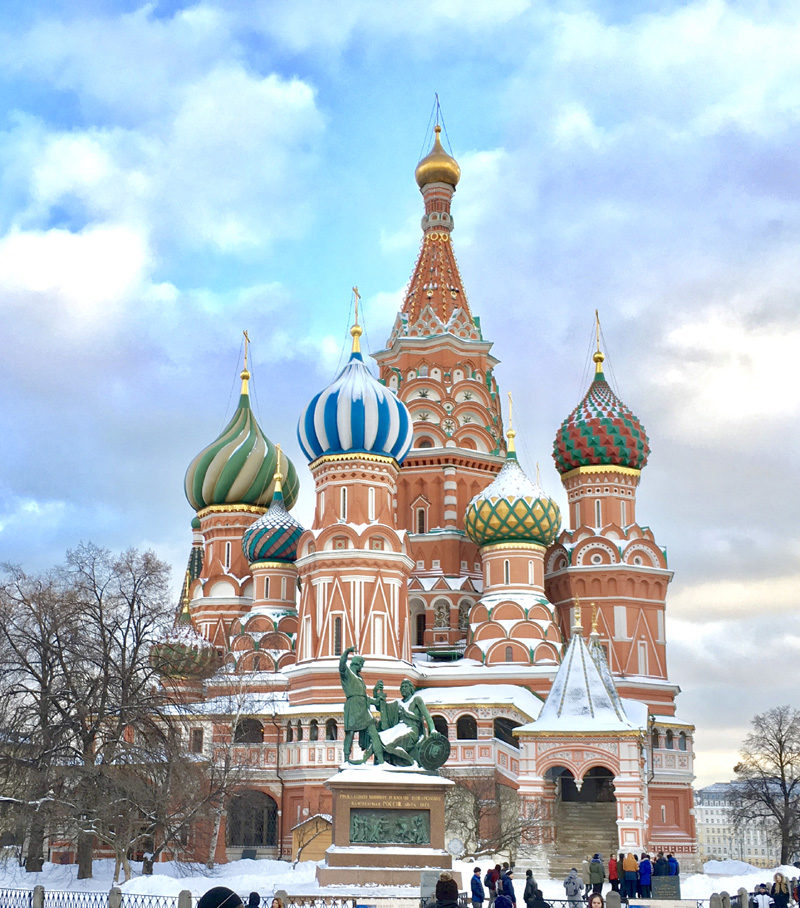
The Cathedral of Saint Vasily the Blessed, Moscow
Привет друзья! Hello friends! As many of you will undoubtedly know by now, Russia is, among other things, the centre of evil in the world. Their insidious hacking knows no limits, their masterful geopolitical strategies have led them to the brink of completely conquering the West once and for all. With their ubiquitous and omnipotent propaganda playing us all continuously like salivating dogs at a Pavlovian bistro, the question for all of us - especially for the dozens of highly-paid patriots in our security agencies - is: how are we to effectively defend ourselves against a scheme that would make Machiavelli blush? Oh, to be sure, there are those out there who would question this "enemy" status, propounding that such realities are the paranoid delusions of schizophrenic madmen, attempting to cajole us into thinking that Russia only desires friendly, mutually beneficial relations, but as I'm sure you're aware, the facts of the matter are plain for all to see.
Wishing of course, to "do my bit" to uphold Western Freedom and Democracy
TM and our glorious liberal values, I embarked early in 2017 upon a voyage into the heart of Slavic darkness itself - even as far as the dreaded Moscow, hoping that I might bring back with me some priceless information that might once and for all expose Russia for what it truly is. Whether I have succeeded in my task I leave for others to judge. And so I present to you, dear reader, this travelogue as an unvarnished account of what I saw and experienced during those fateful four weeks. Let us begin!
Our story commences at Edinburgh Airport, Scotland, on the 5th of January, 2017. The prelude to the story is a Christmas celebration with relatives - a "proper" Christmas celebrated on the 25th of December; none of this January 7th Julian Calendar nonsense thank you very much! We didn't have our calendar adjusted by our wisest men and named after our Creator's dear servant Pope Gregory III back in 1582 for no reason! And Russia dares to call itself a Christian nation! I'll have more to say on that subject soon, but let's stay on track. Upon arriving at the check-in counter for KLM Dutch Airlines, I presented my passport and documentation and was informed by the attendant that I was unable to board the flight as I did not have an appropriate visa for Simferopol, Crimea, my first destination. KLM boarding procedures required a valid visa for the final destination of the flight, and since Crimea was "annexed" by Russia in 2014, a Ukrainian visa, not a Russian one, was required.
Excellent! It was heartening to hear that KLM was taking a stand against Russian aggression by not recognising their annexation and occupation of Crimea. Never mind that it was over two-and-a-half years after the 2014 event and Crimea is now directly under Russian government control. Nevertheless, I felt deep admiration and respect (in no way was I incredulous or exasperated) over the principled stand taken by the airline. Of course, this did leave me with a bit of a problem. I could have flown directly into St Petersburg (my second destination), but then I would have been unable to spend four days in Crimea documenting the no-doubt hideous atrocities occurring there until the tyrannical boot of the Putin regime!
So, given the larger situation at stake, I employed my secret Jedi-like powers of persuasion (by which I mean ringing my travel agent's emergency travel hotline), to convince the attendant that I should be allowed to board the plane, and that the Russian visa should allow me to "go about my business".
Interestingly, in the process of investigating, the attendant actually spoke to the Australian embassy in Ukraine, and was apparently adamantly told that I should not be allowed to board the flight. Presumably, the Australian government wasn't too fond of the idea of Aussie citizens visiting Crimea - understandably so. As I considered the cost of re-booking a direct flight terminating in Moscow so that I could then change planes to get to Simferopol, KLM suddenly advised me that I could fly to Schipol Airport in the Netherlands (the final destination of the KLM flight), provided I collected my baggage and changed flights to Russia myself. Success!
Upon checking in with Aeroflot Airlines to get to Simferopol via Moscow, the attractive Russian lady at the service desk rolled her eyes when I mentioned that KLM had required me to re-check-in due to having a Russian visa for Crimea. The impression was that it wasn't her first rodeo.
Аэропорт Шереметьево, Москва - Sheremetyevo Airport, MoscowAfter a customs clearance that included no Soviet-style trench coats or interrogations by counter-intelligence officials due to my "westerner" status (the process was surprisingly pleasant and straightforward), my first taste of the famous Russian sense of humour came at Sheremetyevo Airport in the departure lounge for the flight to Simferopol. An inconspicuous man asked me where I was from and if I was staying with friends in Crimea. After informing him that I was staying at a hotel, then cordially asking him in return what his business in Crimea was, he chuckled and said, "KGB. Enjoy your flight." before walking away. Given that the KGB hasn't existed since 1991 - the Russian internal security service is known as the FSB - it's pretty obvious that he was pulling my leg. And speaking of humour, the situation in the departure lounge in general was quite funny.
Due to the cold snap that
northern Europe and Russia experienced that year, the conditions on the airport tarmac were -24ºC (-11.2ºF) with blustery wind and snow, and despite two sets of thick glass doors in an "airlock" configuration at each gate, every time the doors opened to let passengers board the shuttle buses for the planes, -24ºC air would blow in just a little bit, causing an intermittent (but accumulative) cooling of the heated departure lounge area. By the time one group of passengers had boarded the shuttles for their flight, all the other people (myself included) would generally be sitting at the other end of the lounge where it was warmest - even though everyone was wearing winter clothing. Then, when passengers at the gate at that end of the lounge started boarding, the temperature would drop in that section, causing everyone to shift back to the previous part of the lounge. This back-and-forth happened a few times before I finally boarded my flight to Simferopol - it was amusing to observe (and participate in!)
I'll note at this point that I made the mistake of not obtaining any Russian rubles in cash at Sheremetyevo because the exchange brokers weren't offering a good rate for the Scottish pounds I had, so I decided to wait and exchange the currency at Simferopol International. Also, approaching the point of having been awake for nearly a full day and after having taken two flights already while being focused on making a third, it didn't occur to me to simply withdraw some rubles directly from an ATM. Lesson folks: Always make sure you have plenty of cash in local currency BEFORE leaving the airport - preferably before entering the country! It's easy not to remember this in this 'digital' age of merely waving our phones or cards around in order to make 'cashless' payments.
Boarding the flight itself was an interesting experience. If you've never taken a flight before, boarding an aircraft from the tarmac in everyday, temperate conditions is what you'd expect. Boarding one at night in blustery, snowy, -24ºC conditions however is very different. By the time I had made it up the stairway (approximately 2 minutes), my mustache was covered in ice, I was shivering with cold, my nose was running, and I was thinking that my winter clothing (that had seen me through the Edinburgh winter quite toasty warm) was not quite up to the task. Fortunately, I was not the only one - the Russian passengers themselves seemed to be 'enjoying' the cold as much as I was - and I noted with satisfaction that the Russians seemed to have human sensitivities too; they are not the invincible super- men & women that Putin's propaganda would have us believe.
The flight from Moscow to Simferopol took approximately 2.5 hours, with the experience of another phenomenon I'd vaguely heard about - Russian aircraft passengers applauding their pilots after a successful landing. Nobody in the west does that! Surely this is the remnant holdover of some kind of Soviet brainwashing campaign from the USSR days. Pilots are paid to do a job, and yet these people are according the pilots extra gratitude simply because they have responsibly delivered them to their destination alive and well! I mean, what's up with that?!? Clearly, I was going to have to pay more attention to these cultural brainwashing patterns so as to gain a better understanding of the Russian mind.
Симферополь, Крым Simferopol, Crimea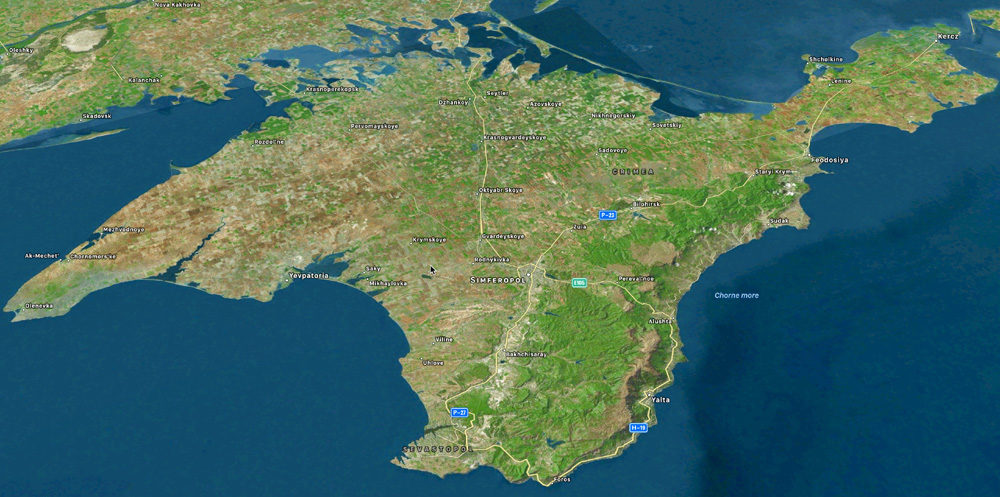
Satellite view of the Crimean Peninsula
After disembarking at Simferopol International Airport, my first requirement was to obtain some Russian rubles. This proved to be harder than anticipated. Although it was difficult to be 100% sure with all the signs written in Cyrillic, there seemed to be no currency exchange kiosk or store on the premises that was open (I later found out that some news agency booths perform currency exchange in Russia, plus there may have been extra facilities in the Departures area of the airport, which was physically separate from the Arrivals area). With plenty of ATMs available though, the next step was to try one of those, so I picked an ATM of one of the more popular banks in Russia - Сбербанк, or "Sberbank". After accepting my card, PIN number and transaction details, the machine gave a "SWIFT routing error" when trying to process the transaction, then returned my card. Odd. The error was repeated several times and with several other ATMs. Suddenly it hit me:
Sanctions! Alas, I had failed to remember that Crimea was completely isolated from the VISA and MasterCard SWIFT payment network - although not the rest of Russia - for giving itself up so easily to the Russian invaders.
No problem - I had prepared for any payment difficulties by purchasing a payment card that operated on the Chinese UnionPay network, lest I should end up in any places where VISA wasn't available. Unfortunately, none of the ATMs accepted UnionPay cards. Problem. I was forced to rely on the Scottish pounds I had on me. Unsurprisingly, this did not prove to be an agreeable option to the various taxi drivers out the front of the terminal so, after a minor side-adventure involving a long, sleep-deprived walk in an industrial area, a heavy backpack, outdoor markets, an alcoholic beggar and a Good Samaritan (Саня, you are a champion!), I arrived safely at the Отель Спортивная (Hotel Sportivnaya) in central Simferopol with plenty of time still to explore in the afternoon.
On the way to the hotel, I had noticed a curious phenomenon. Quite a few drivers had attached small Russian flags to their vehicles, presumably in some kind of show of solidarity with the new authority in the region. One or two large billboards also prominently displayed Putin's image, with an inspiring quote alongside. Despite that these billboards were relatively few compared to other regular advertisements, these were clearly signs of a Russian effort to foster positive feelings among the people of Crimea towards their new master, and the flags on the cars were showing that the signal was being received by the people (no doubt begrudgingly).
Upon setting out to see the city, a distinction became apparent - many old buildings appeared to be more "Soviet-style" in appearance, yet they often contained a portion that was recently renovated, usually presenting a business of some kind. This was a trend I was to observe throughout many other Russian cities - a kind of "old meets new" that probably reflects a growing economy and vibrant culture emerging from the "hard times" of the disintegration of the USSR. Towards the city centre, the modernisation trend became far more apparent - many shops, buildings, malls and boulevards had a distinctly cosmopolitan, even "Western" feel to them; locals and tourists mingling together in sightseeing and commerce.
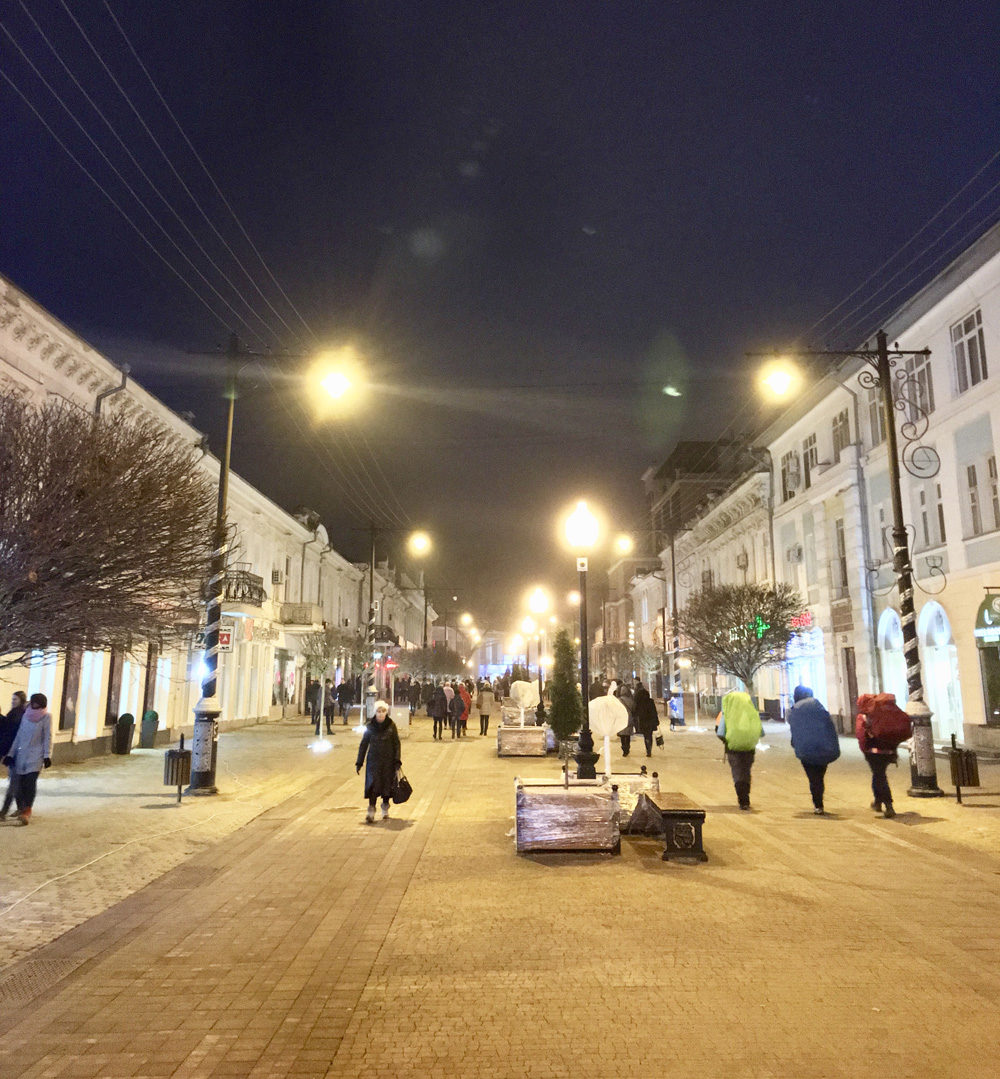
Karl Marx Boulevard, Simferopol
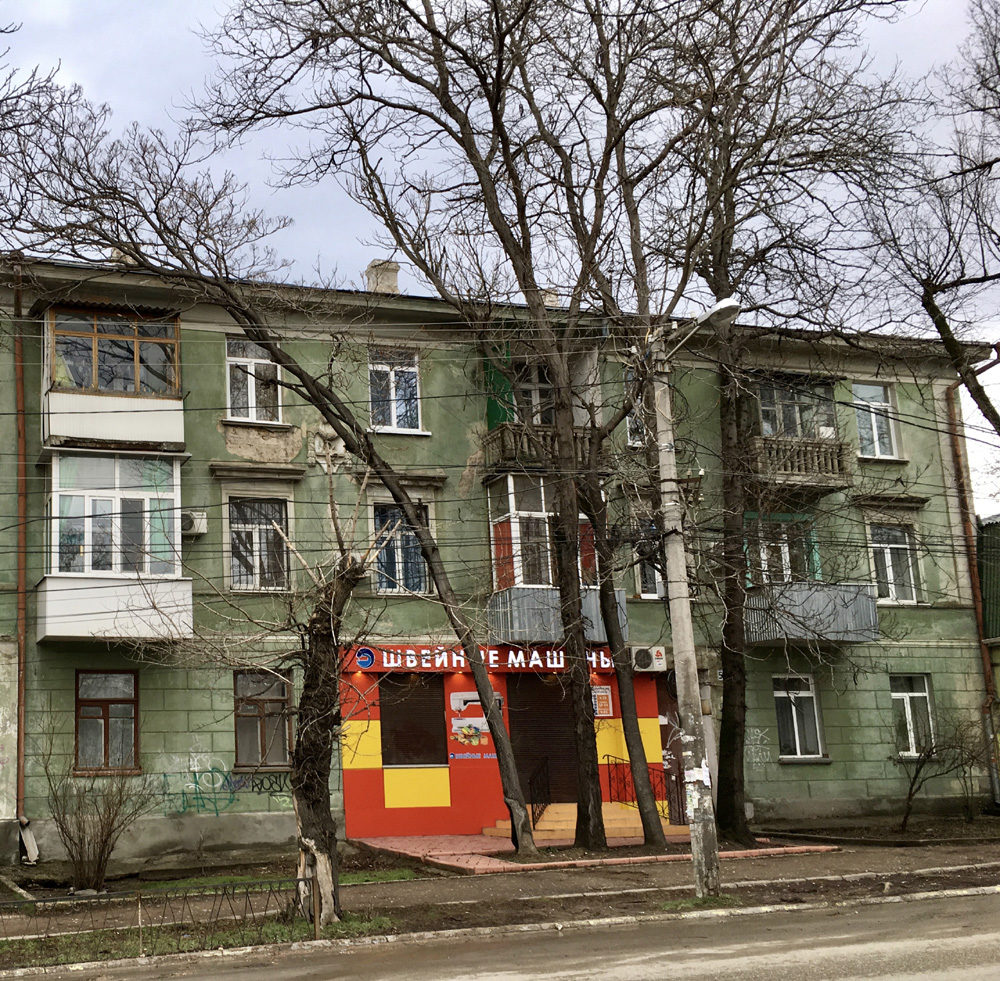
Old-style Soviet apartment block with new shop at street level
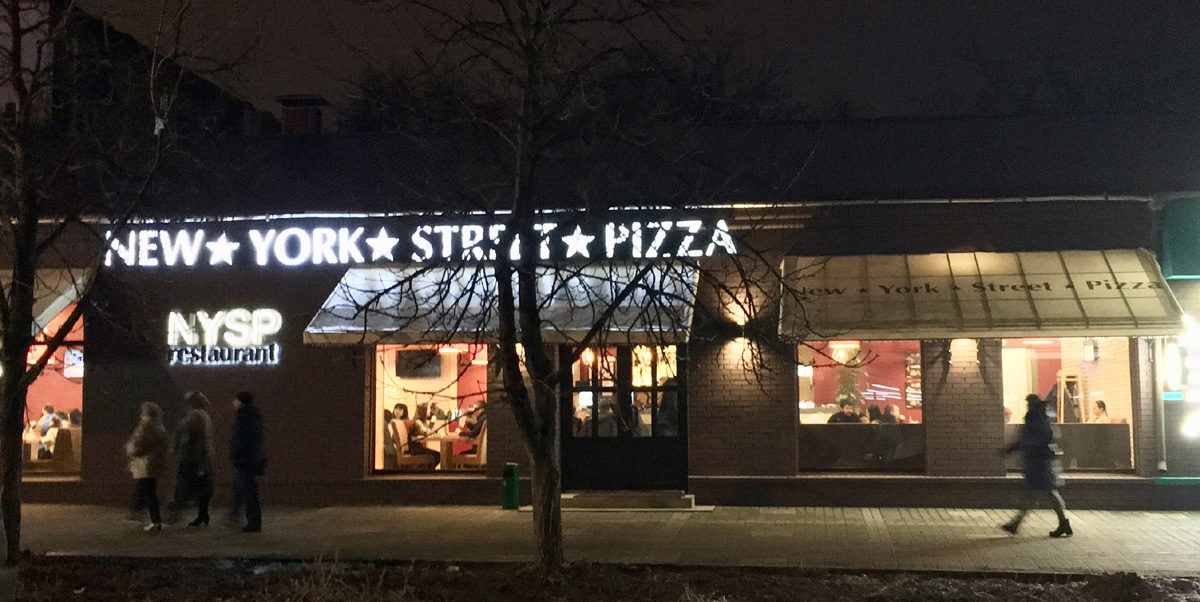
New York-style pizza is famous everywhere!
As the evening drew on, many shops remained open, and I noticed another phenomenon that was to recur throughout other Russian cities; the playing of Western music and songs in English, despite the almost total absence of any significant portion of the population that spoke (and presumably, understood) it. What was this all about? Are Russians and Westerners similar in some way regarding their love of the "universal language" as it has been called? Later, one Russian lady, Гала, gave me the answer to this: it is likely the result of a sort of "rebellion" against the times when western music was forbidden by the Communist government, and so now Russians play western music at every opportunity as a sort of 'celebration' of their freedom from the former regime. I was again presented with a question though: if such is the case, if they admired western culture so much, why did they allow an apparent dictator to usurp their hearts and minds rather than embracing their fledgling democracy to the fullest in the new Ukraine dominated by neo-Nazi and the shoo-in chocolate king Poroshenko? Clearly, the situation was not as black-and-white as I had previously imagined.
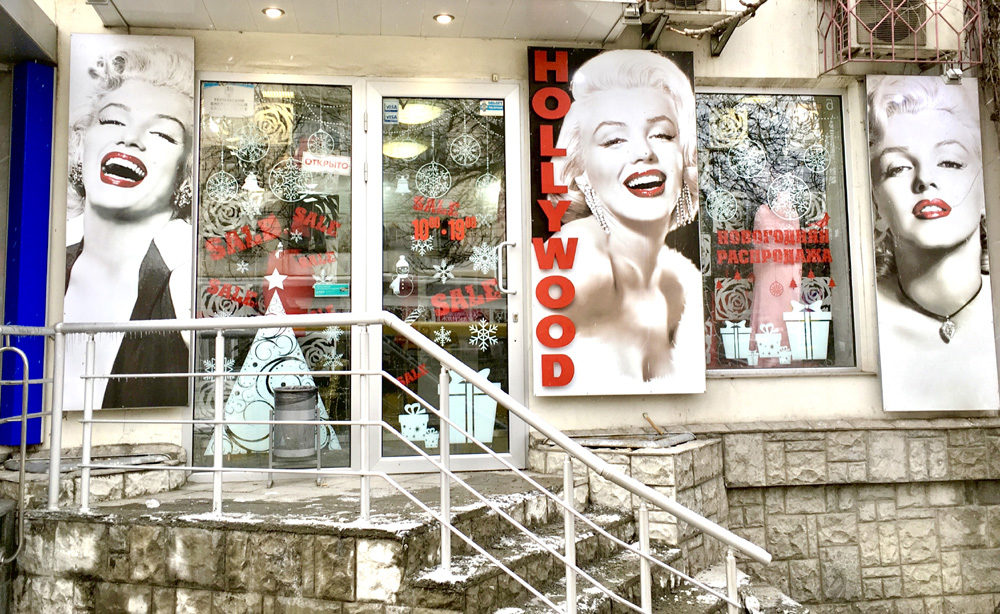
Marilyn Munroe - an iconic beauty legend all around the world
After admiring the intricate and beautiful displays of Christmas-themed artworks - I had arrived in Simferopol on the Eve of Russian Orthodox Christmas - I walked down to Lenin Square (practically every city in Russia has a square named after Lenin), in which preparations seemed to be underway for the town's main public Christmas festivities. Noting this for later, I then returned to my hotel, to gain a refreshing full night's sleep after the previous few days of hectic travel.
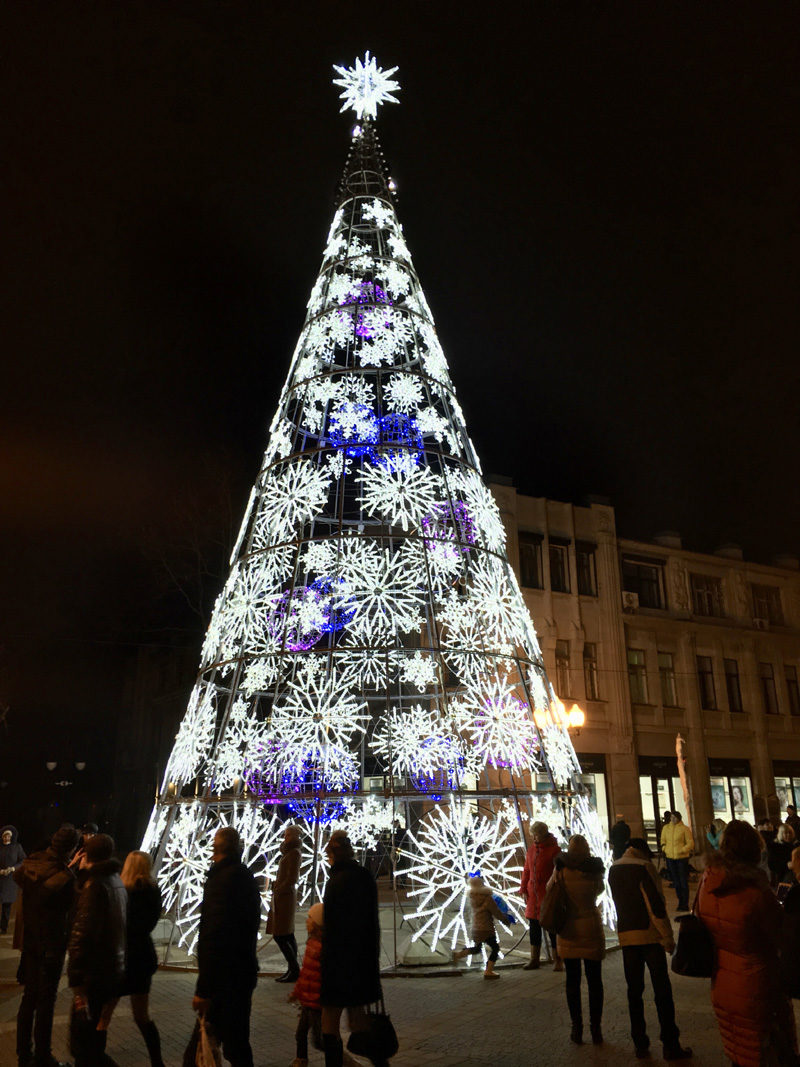
LED light sculptures installed as Christmas decorations in Simferopol
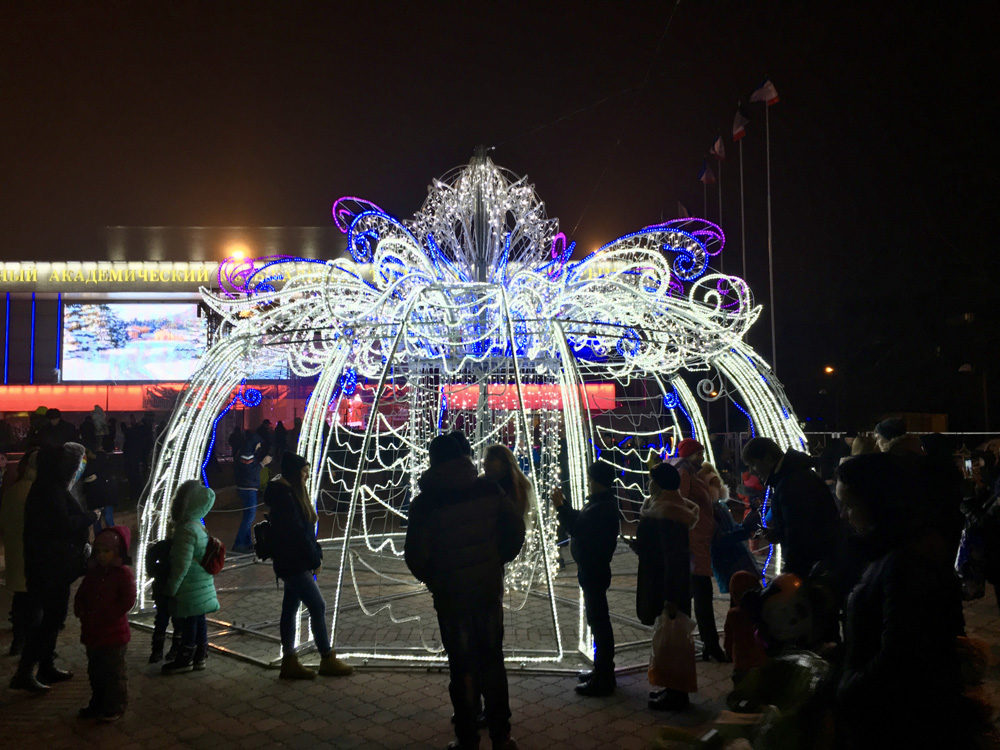
LED light sculptures installed as Christmas decorations in Simferopol
Awakening on orthodox Christmas Day, I looked outside and my heart leapt - снего! (snow!) The city had received a gentle blanket overnight, covering everything in a crisp layer of purest white. With a temperature of about -7ºC (19.4ºF) outside, the day was brisk, but not uncomfortable with the appropriate clothing. A layer of thermals underneath jeans, with a long-sleeved T-shirt, thick ski jacket and a woollen beanie were sufficient to keep comfortably warm throughout the day. Venturing once again into town, I pondered that going four days without any available funds would be difficult, even with the essentials all paid for in advance, and a small supply of food I had brought with me. Travel Tip: Always have some nutritional high-energy-density food packed as part of your luggage - hazel or macadamia nuts, dried fruits, dark chocolate, beef jerky, protein balls etc make excellent emergency (even non-emergency!) travel rations. And remember a bottle of water, too!
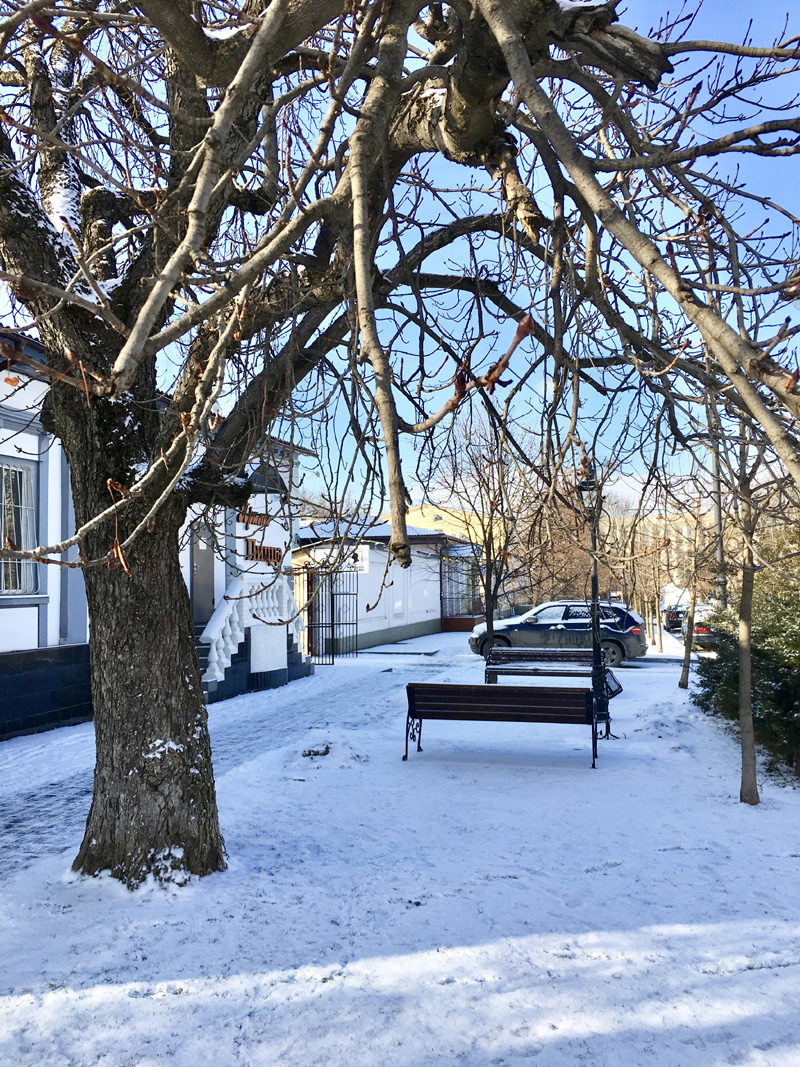
Light snow blankets the city of Simferopol, Russian Christmas Day
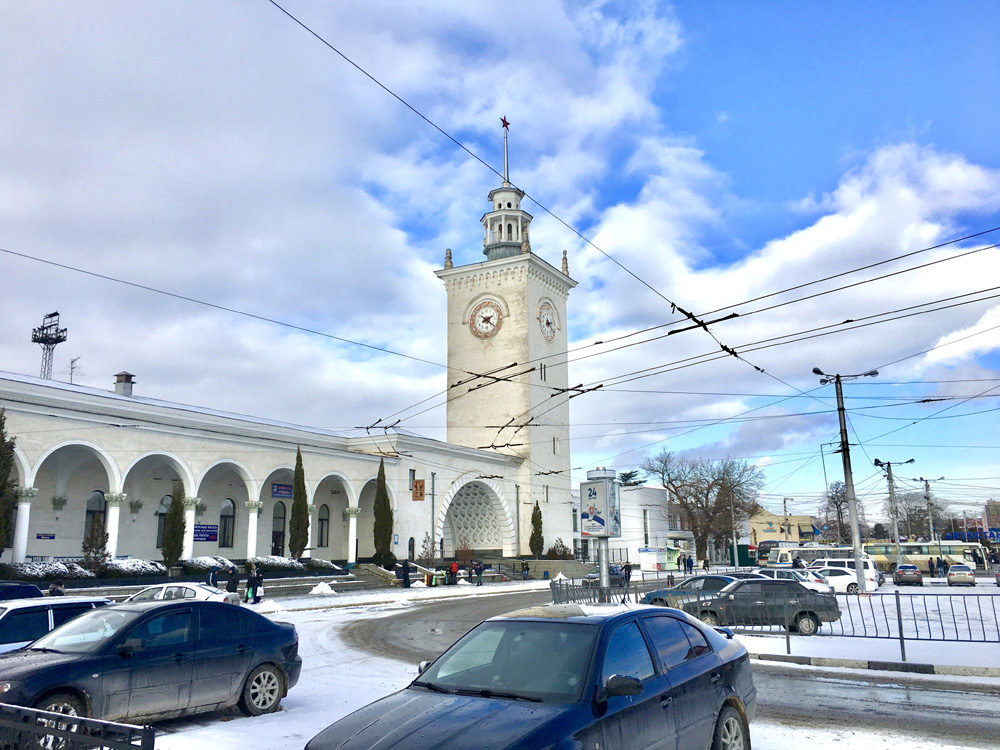
Central Train and Transit Station, Simferopol
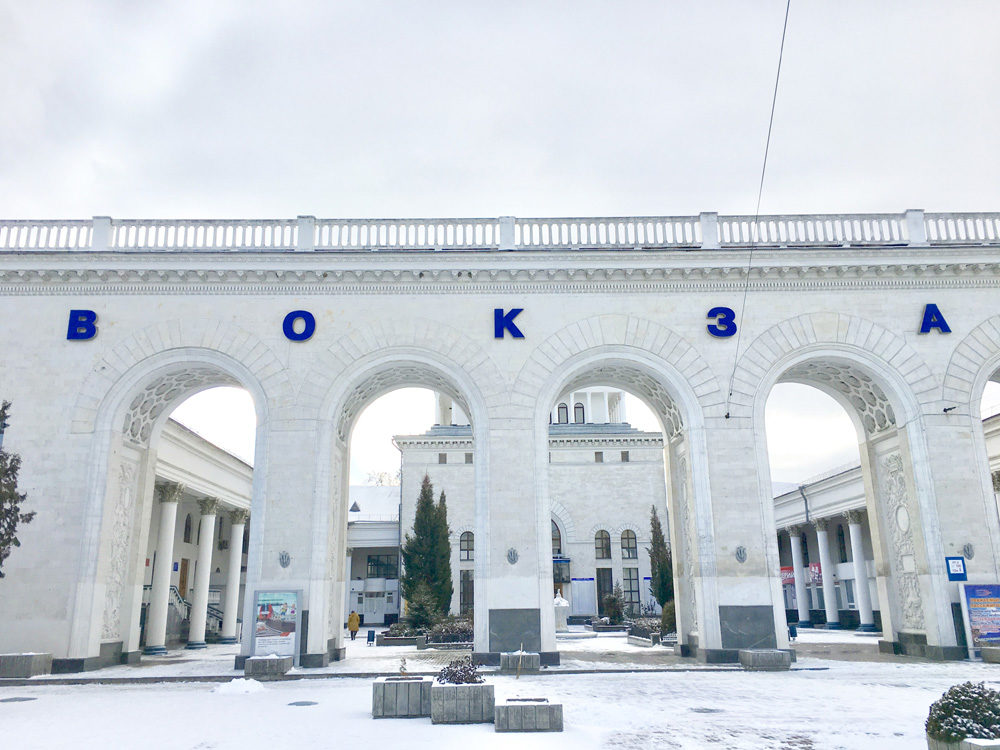
Unique Greco-Roman architecture adorns the Central Train and Transit Station, Simferopol
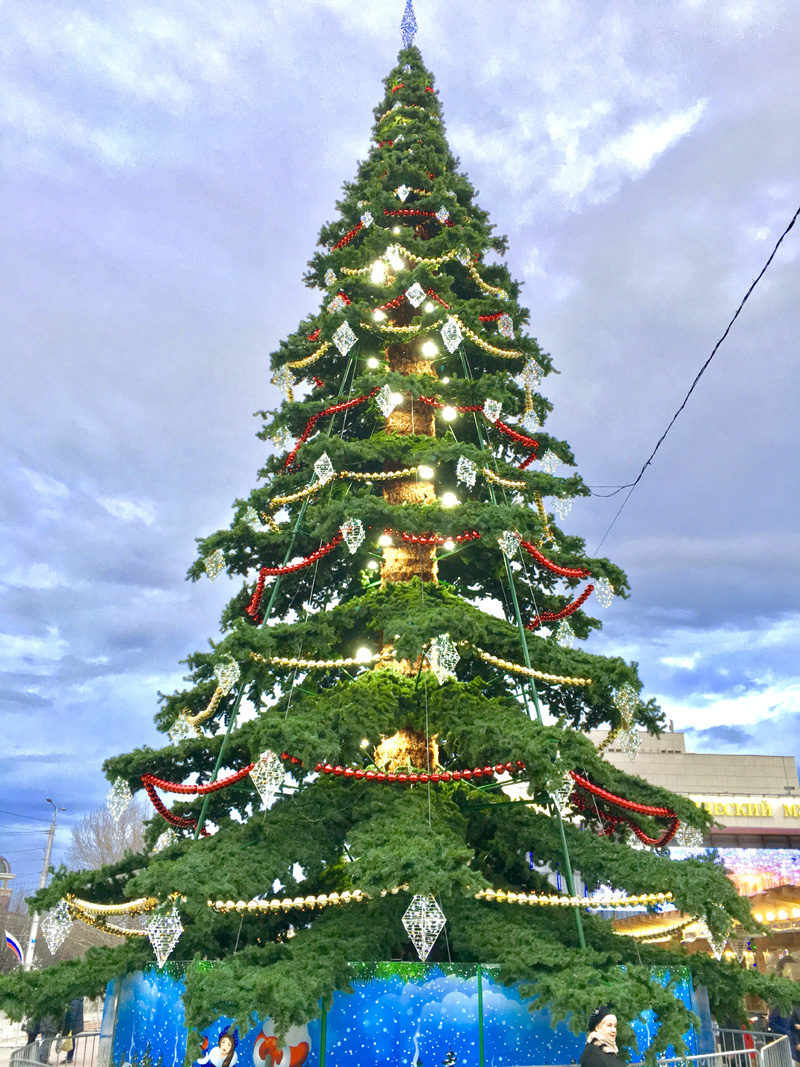
City Christmas Tree, Lenin Square, Simferopol
The concierge at the hotel, although quite a good speaker of English, had been unable to help me, pointing out that banks and cash exchange facilities would be closed. Relying on some advice discovered via online travel guides - Russians are much more used to haggling as part of their culture - I attempted to find an agreeable merchant to do an 'unofficial' currency exchange. It turned out that I was in luck - either side of Lenin Square the locals had set up their Saturday markets, even on Christmas Day, so there were a wealth of vendors available to inquire about the prospective transaction. It didn't take me long to find an amiable businessman willing to do a deal. Between some handy translation apps on my phone (look for ones with offline functionality!) and some phrasebook Russian and English, a mutually-beneficial trade was made, and I went on my way with a pocketful of rubles. Success!
Upon browsing the markets for a more substantial meal than my fare of the previous few days, I began to notice the benefits that western tourists can enjoy in Russia vis-a-vis the exchange rate. Prices were excellent, typically three to four times cheaper than in western countries - sometimes more depending on the product. Large slices of pizza cost the equivalent of about $1.70 US, and I noticed open-air butchers (something that people are able to do in Russia in the winter - no on-site refrigeration required!) were selling multi-kilogram slabs of meat for under the equivalent of $10 US. My BBQing genes activated a primal response within me, but purchases were not practical given my accommodations, so I restrained myself. A significant variety of items were on sale at the markets; many vendors were selling quality winter clothing essentials - wool socks and mittens, hats and coats etc, for prices that would only be seen in discount shops in western countries.
During my shopping and window-shopping, I met and briefly chatted with a young local girl who actually could speak English reasonably well. I asked her, among other things, what she thought of Putin, and received a cautiously optimistic answer although she expressed a general disinterest in politics typical of her age group. Overall, the mood in the streets seemed upbeat and relaxed (as one might expect on Christmas Day), and as the sun went down in the evening, the
festivities began.
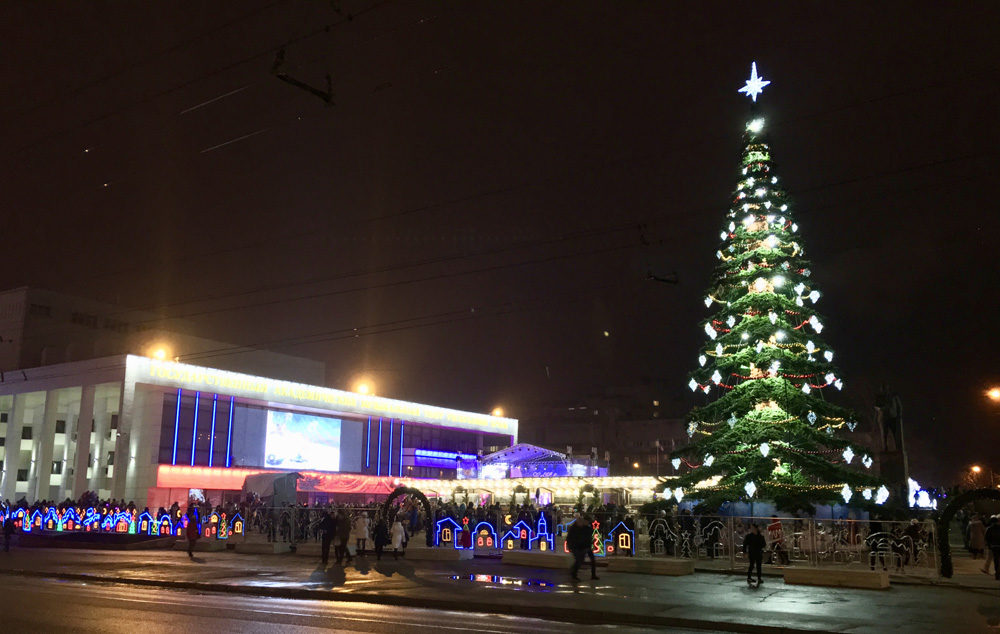
Christmas Festival, Lenin Square, Simferopol
In the video linked above, you might have noticed several figures that look like Santa Claus, and a woman dressed in white; these are the popular Russian mythical characters Дед Мороз ("Ded Moroz", or "Grandfather Frost") and his granddaughter Снегурочка ("Snegurochka", or the "Snow Maiden"). Some of their fairy tale activities are similar to Santa Claus, with them delivering presents to young children at the beginning of the New Year.
These characters first took on a greater prominence in Russian Christmas celebrations during early Soviet times, when they were re-introduced to give what was then a primarily religious festival a more secular focus. After taking power, the adolescent Communist regime had officially banned Christmas due to its religious nature, however 15+ years of a failed cultural policy later (who would have thought that prohibiting a major religious/spiritual holiday tradition would prove unpopular with people and be ubiquitously ignored?) the government conceded a 'substitution' of customs.
Nowadays, both 'secular' and religious traditions are celebrated in Russia, although it appears that the Eastern Orthodox Church has enjoyed a massive revival since the collapse of Communism in the 90's.
On this subject, I think we need a little straight talkin': every God-fearing Christian must admit these Russian "Christians" are heretics. The Bible clearly states somewhere, probably, that Jesus Christ was born on the 25th of December. And he speaks English in the Bible, not Russian. And he told his disciples not to interfere in elections via social media, either. Sort of. It's there if you read between the lines. Freedom and democracy. So what if the Eastern Orthodox Church is the second-largest Christian church in the world? They clearly decided to go their own way in the
Great Schism of 1054, and obviously don't appreciate the divine wisdom expressed by the papal hierarchy. There can be only one, true, Universal Church, and if they don't want to get onboard, well, they can all burn in hell, along with the Buddhists, Muslims, Hindus, Mormons, Taoists, Zoroastrians, Rastifarians, Sikhists, Mithraists, New Agers, Occultists, Satanists and, of course, Jews.
Anyway, after an enjoyable evening taking in the sights and celebrations, I awoke the next morning and made my way to Simferopol's central train station in order to catch a trolleybus to my next intended destination: Yalta.
Ялта Yalta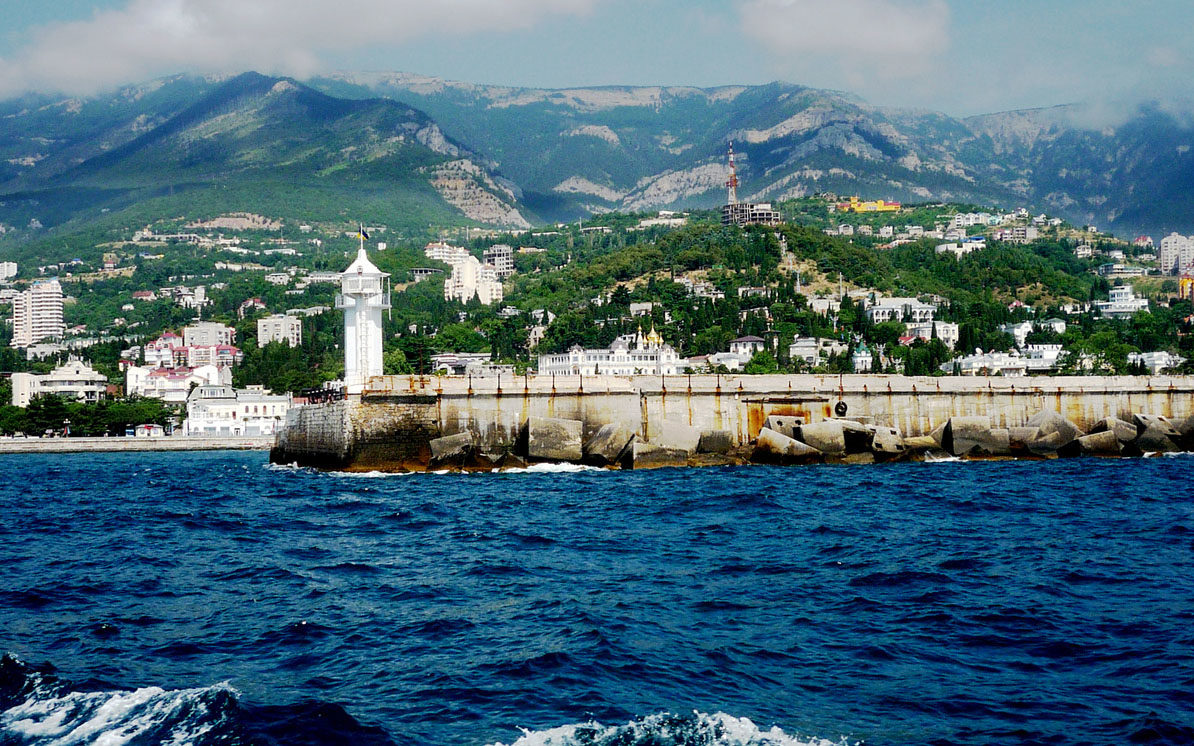
Yalta’s locale, on the Crimean Black Sea coastline, is extraordinary
Yalta is a resort town on the north coast of the Black Sea, famous for its beauty and hospitality, and was frequented by the higher echelon of the Communist Party during the days of the USSR. The city nestles comfortably in the hills and valleys of the coastline, while the Crimean mountains soar upward behind it, providing an exhilarating view that has to be experienced to be fully appreciated. Only a two-and-a-half hour trolleybus ride from Simferopol (the trolleybus route to Yalta is the longest in the world, at approximately 56km), the town has a cosmopolitan, relaxed feel, with numerous resorts and tourist attractions.
Some of the larger palaces have been opened to the public, providing a glimpse into the days of the Soviet Union and the late Russian empire;
Livadia Palace, the last Tsar's vacation residence was the site of the 1945 Yalta Conference at which Stalin, Churchill and Roosevelt planned the post-World-War-II world order. Other famous landmarks such as the "
Swallow's Nest" are only a short drive (or long walk) from the city. On the way there, I had the chance to enjoy some Russian cinema on the trolleybus via an installed television. Although I was unable to understand the dialogue in the movie, it was nevertheless quite entertaining - a kind of "Tarzan" story about a man raised by monkeys that is re-educated by scientists to become a normal member of society.
Arriving quite late in the day at Yalta, I didn't have much time to explore the town before catching the last trolleybus for the evening back to Simferopol, nor was I able to take photographs that conveyed the full grandeur of the natural surroundings. However, the Christmas celebrations were still in full swing, with "light sculptures" around the plaza and esplanade area, bands playing, and a mood of general merriment. Restaurants were packed, and stores, open into the evening, were doing a thriving business. It all felt somewhat surreal - where were the jack-booted thugs supposedly cowing the population into line at the behest of Putin's invasion force? The police presence was no greater that what one might expect at a public Christmas celebration in any western city. Had the population been brainwashed so quickly that military guards were no longer required? Or was Putin bribing them with Christmas circuses so that they would forget the injustice of being rudely wrenched from the loving bosom of their Ukrainian family? Alas, my language skills were limiting my ability to investigate the secret tortures which were no doubt bubbling under the surface of an otherwise happy and prosperous town. I had thought taking some surreptitious photographs of evident brutality would have been a relatively easy job. After all, the notion that things were simply as they appeared to be was quite preposterous, and clearly would imply that our patriotic and dutiful western media might have been less than impeccable regarding their fact-checking - as if!
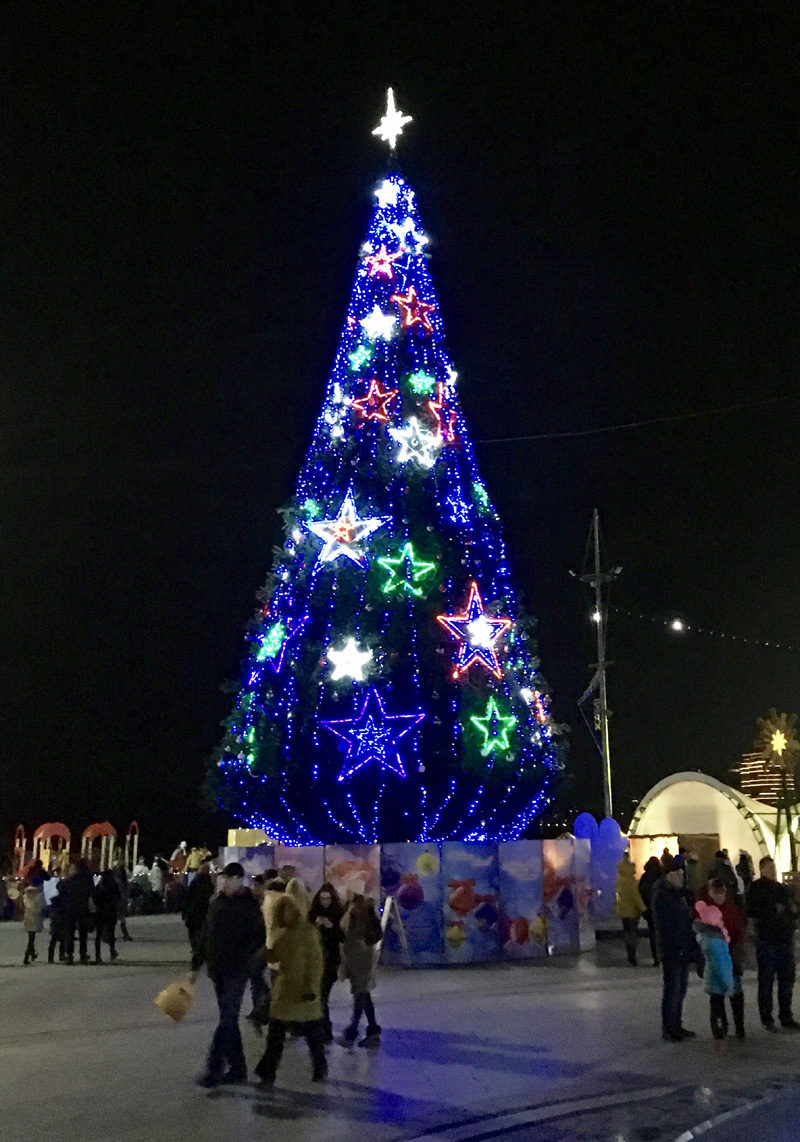
Christmas light sculptures at Lenin Square (pretty much every Russian city has one!), Yalta
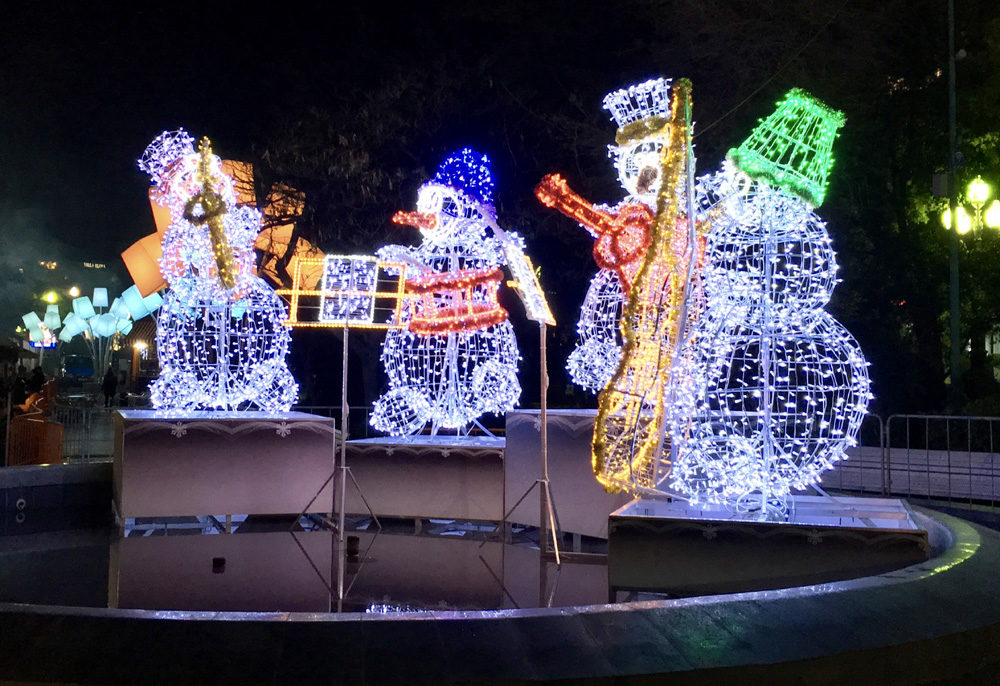
Christmas light sculptures, Lenin Square, Yalta
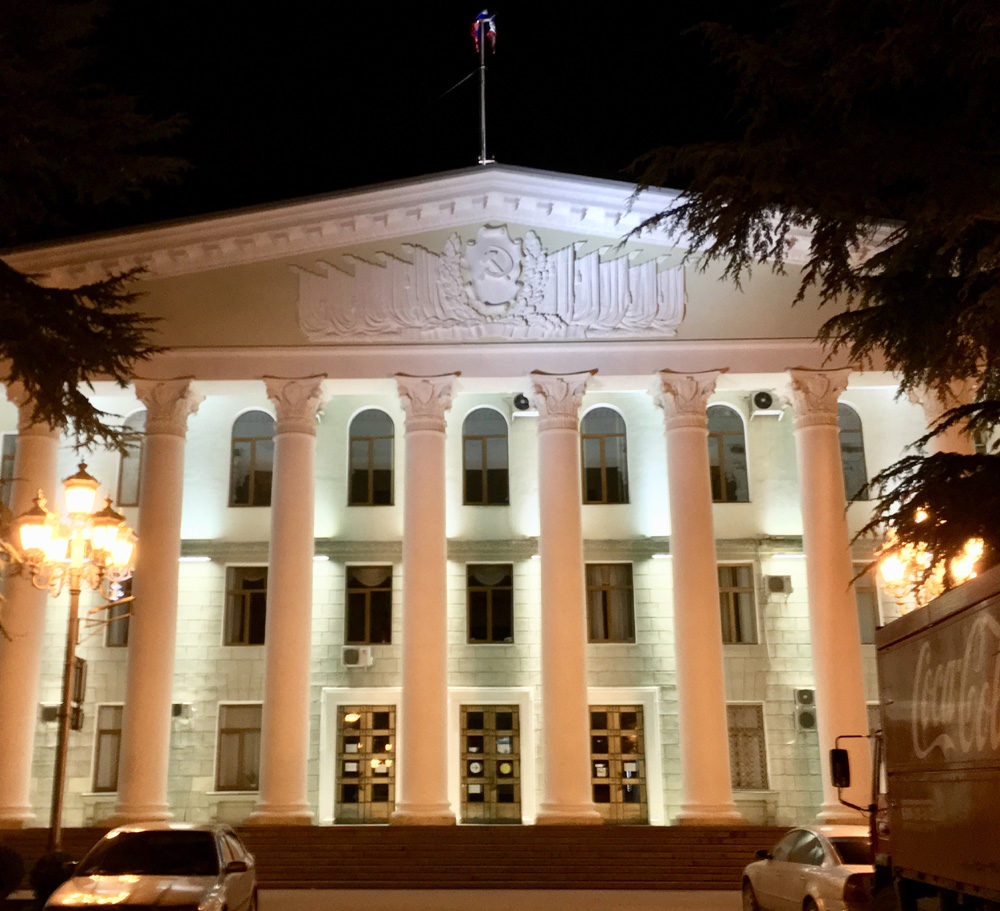
Yalta local government office, Yalta
After bookmarking Yalta as a definite "must see again" destination, I returned to Simferopol, to investigate some of the city's more well-known places before my departure to St. Petersburg.
Sights of Simferopol (Симферополь)Just near the city centre I was astonished to discover a "Parliament Building". Apparently, Crimea has its own Parliament that hosts elected representatives from all areas of the peninsula as if it was a sovereign nation of its own! This parliament building was completed around 1988, just before the fall of the USSR, while Crimea was still governed by the Crimean Autonomous Soviet Socialist Republic.
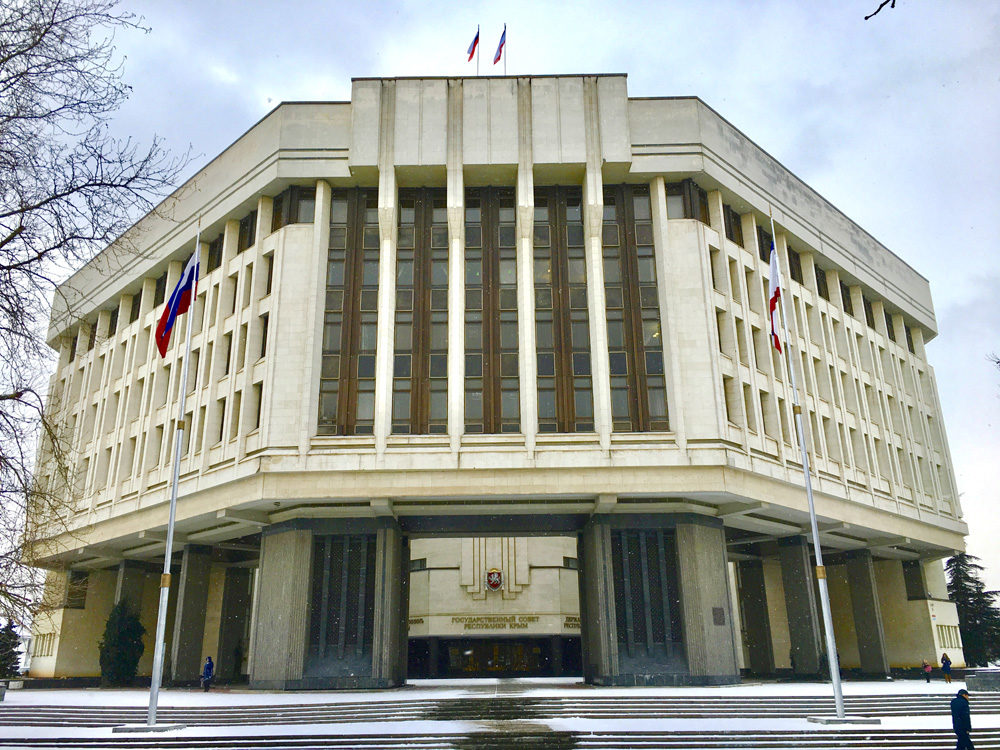
The State Council of Crimea Parliament Building, Simferopol
Post-USSR, the Republic of Crimea was formed, and the first Crimean Constitution was adopted, however this only lasted a few years before the Ukrainian government dissolved the Republic's government and established the Autonomous Republic of Crimea with a new Constitution. This sounds a lot like "annexing" to me, which I thought only the Russians did. Odd.
In 2014, the region declared independence from Ukraine and formed the State Council of Crimea, the current government. They then voted to apply to join the Russian Federation, and even held a referendum to that effect. I was surprised to learn that mainstream media in the west actually reported this - all I remember was them talking non-stop about "annexation". If a referendum took place though, doesn't that mean that Crimea joining the Russian Federation was.. a democratic process?
What is going on here? A Parliament building, a referendum voted on by the people... does this mean that Crimea really has freedom and democracy? Could I have been mistaken about Putin's ferocious military sweeping through peaceful Crimea?
My head spinning, I turned and examined the building opposite, the Church of St Alexander Nevsky. Begun in the late 18th century, the original church was destroyed in 1930 by Communists and was only rebuilt in early 21st century. A Russian Orthodox Church, it sits in the centre of a large plaza that also includes a memorial to Crimea's liberation from World War II. The cathedral was dedicated by Empress Catherine the Great to famous Russian Prince, general and nation-builder, Alexander Nevsky, who was canonised in 1547.
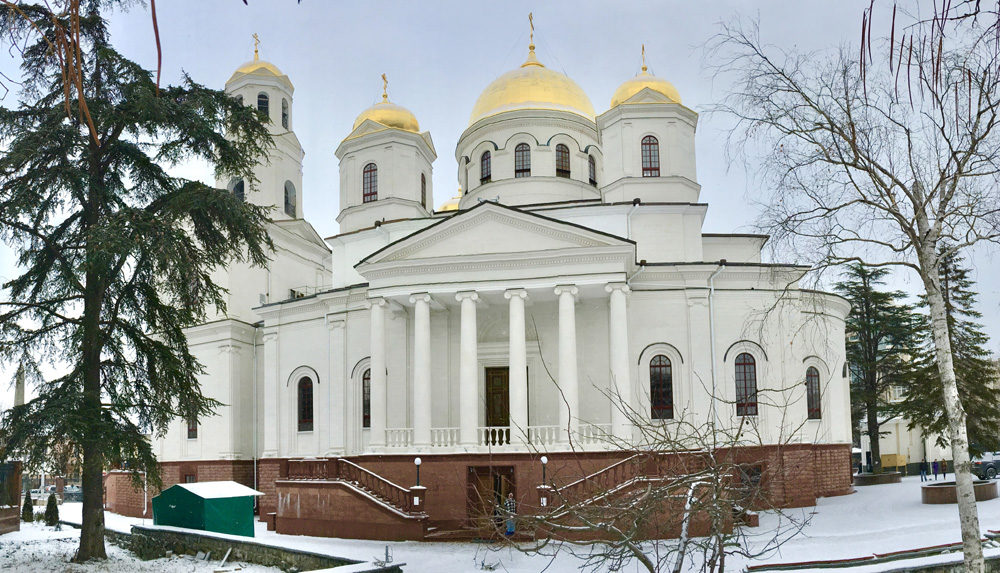
The Cathedral of Saint Alexander Nevsky, Simferopol
Nevsky is more than an interesting historical figure. His legacy (among other things) was to preserve and strengthen Eastern Orthodox Christianity and to unify the Rus people. The legendary "Battle on the Ice", where the Teutonic Crusaders were defeated by the Army of the Republic, has archetypal echoes of the 1941 Battle of Moscow. In 2008, popular public polls resulted in him being named the "main hero of Russia's history", and "greatest Russian".
The World War II Liberation memorial commemorates a significant event in Crimean history, the liberation of the Crimean peninsula from German occupation during the Second World War (or Great Patriotic War, as it's known in Russia). While occupying Simferopol during the war, the Nazis perpetrated one of the worst individual war-time massacres here, murdering over 22,000 locals; the victims were mostly Jews, Russians, Krymchaks (a Turkic-speaking Orthodox Jewish sect), and Gypsies. The decommissioned tank in the memorial symbolises the instrumental role Red Army tank battalions played in liberating the peninsula.
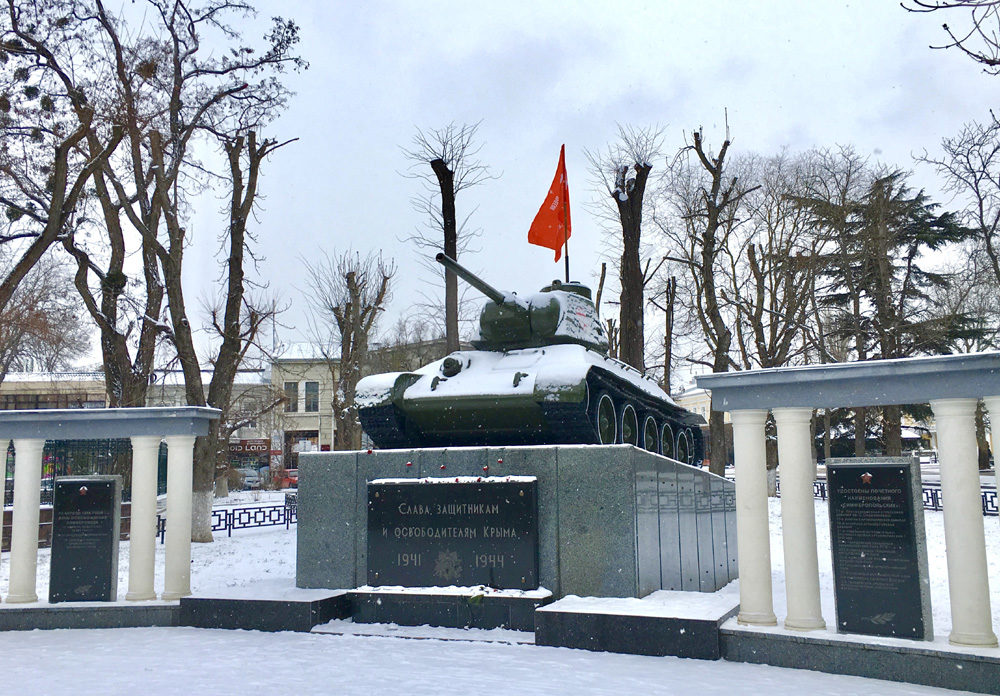
Memorial to the liberation of Crimea from the Nazis in the Great Patriotic War
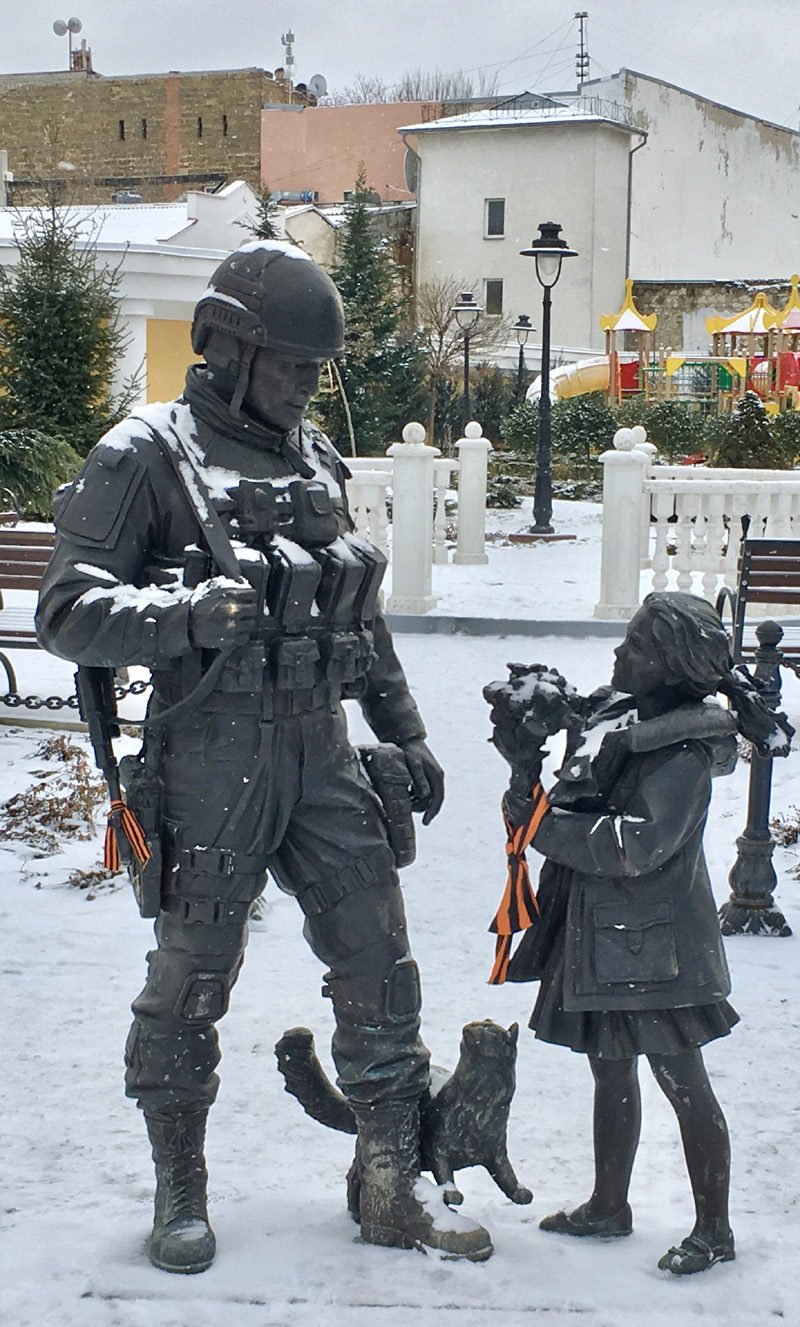
Locals hang orange and black “Victory” ribbons around statues symbolising peace, in Simferopol
Turning from these thoughts of 'war and rumours of war', I continued along one of the pedestrian boulevards one block across. It was here I discovered in the equivalent of an open-air 'mall', a nice phenomena - a vendor providing pony rides to young children in the Christmas snow. A young Russian family kindly let me take a photo of their daughter riding one. Perhaps there is some good in Russia after all?
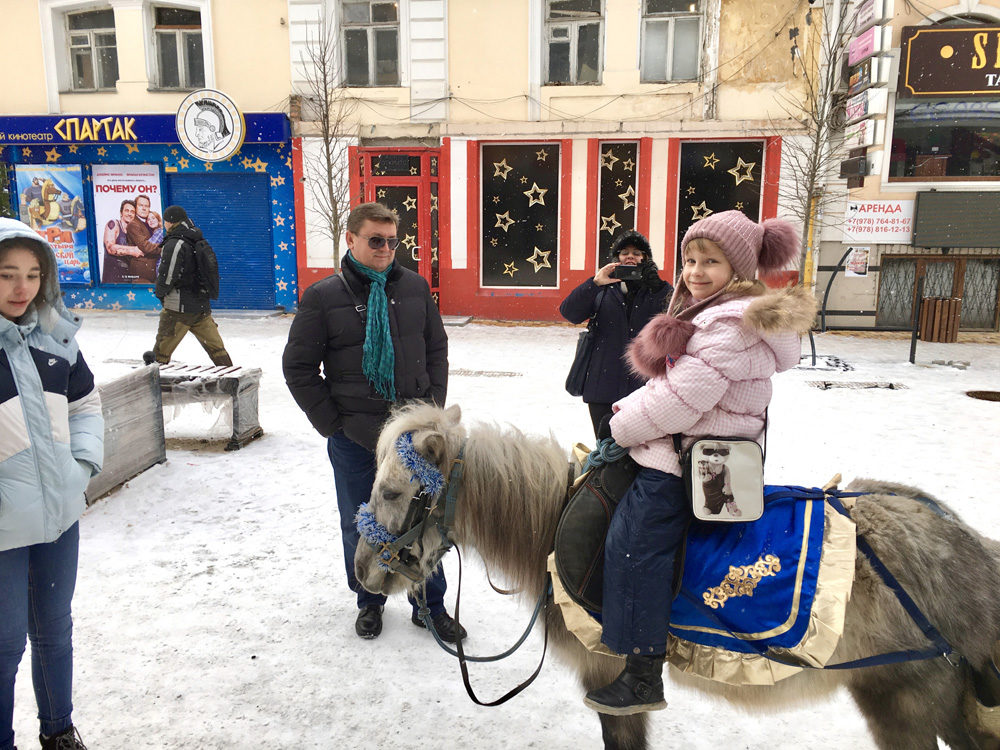
Young girl enjoys a pony ride through one of the main outdoor malls, Simferopol
Still, I knew I would have to keep my wits about me; I was in a place saturated with Putin's propaganda... I would have to ensure I was not unwittingly swayed by wholesome images of family values that merely served to cover up a brutal occupation regime!
The following day, after hiring the taxi services of my Good Samaritan friend Саня for my journey to the airport, we chatted briefly on the way in limited English about life in Crimea. He told me that Crimea in summertime was a very beautiful place, and was a much different experience to the winter, extremely popular with Russians as a tourist destination. With amazing new
resorts such as the Mriya in Crimea, I could not help but wonder if a dedicated holiday specifically to Crimea during the summer might be a good idea! It certainly would be great to just relax for a week or two and soak up the ambience. As of April this year, the
new upgrade to Simferopol International Airport has been completed. With a capacity of half a million passengers per month, Crimea is sure to be a tourist destination
par excellánce once normal flight schedules from nearby nations are re-established.
As I settled into my Аерофлот flight to St. Petersburg, I reflected on the past few days, and wondered if perhaps Crimea was not yet as thoroughly controlled as the rest of Russia surely was. No doubt in a major Russian city, especially one situated close to the freedom enjoyed by European countries, I would find evidence of the totalitarian repression I was looking for. Putin might have outsmarted me in Crimea, but I would be extra vigilant in St. Petersburg! Stay tuned for Part 2!
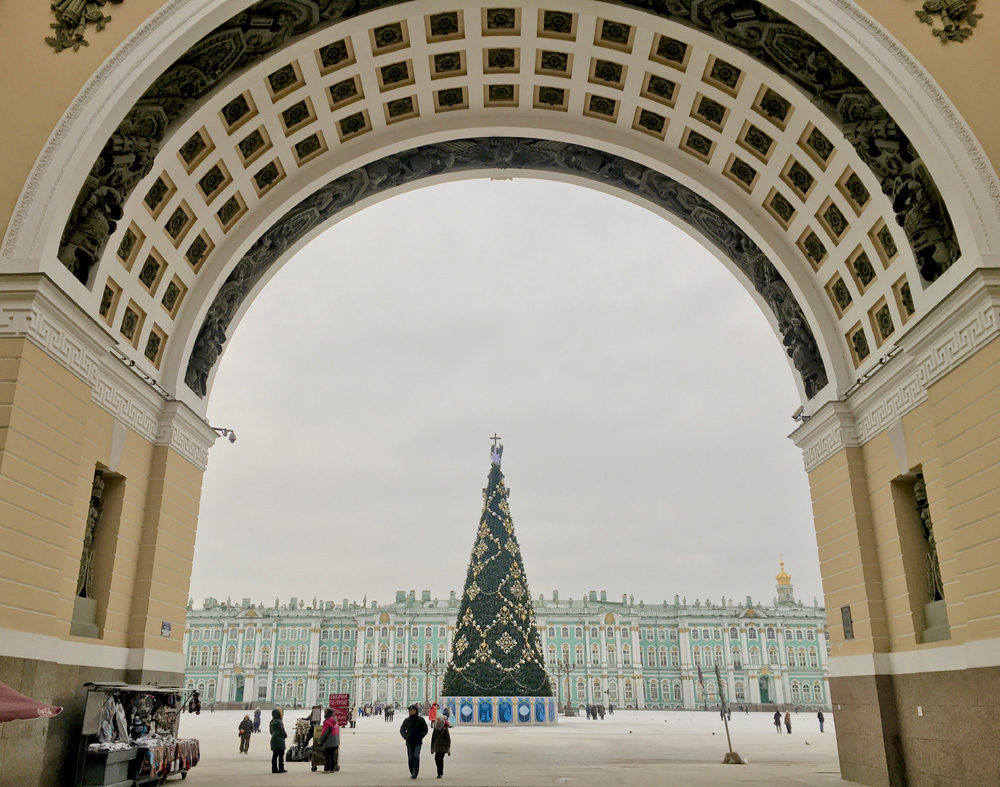
Entrance Archway to Palace Square on Bol’shaya Morskaya ulitsa (street), St Petersburg
Reader Comments
I can't believe that KLM and the Australian Embassy (in Ukraine) would be so idiotic as to give you such bad advice about visas. If you had taken that advice, I don't think Crimea would have allowed you in.
Or Adam to Eden
Or Perihelion.
Roman Saturnalia, not Xianity.
He he he